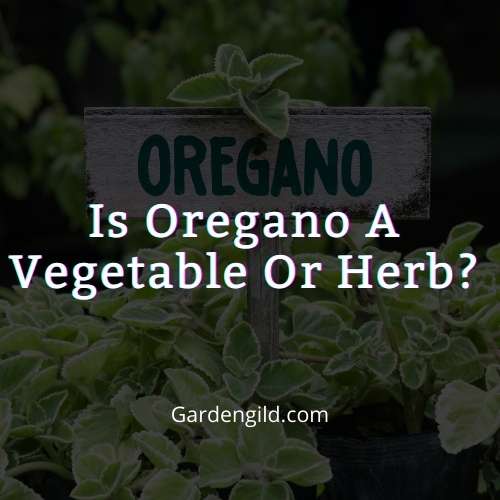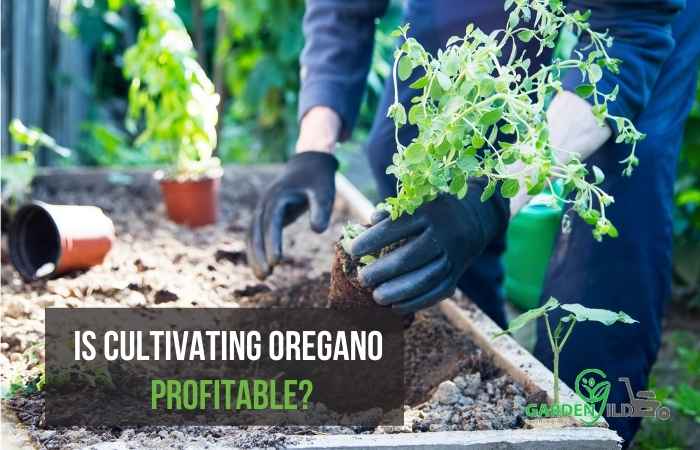Oregano is a frequent herb mostly used in Italian cooking. It’s a hardy plant that makes a gorgeous ground cover and is useful in cooking. It can be cultivated both inside and outside, which means there is no issue with any place you live; you may have your organic oregano with just a little time and dedication.
People often ask me about is oregano a vegetable?
No, oregano is not a vegetable; it is a herb.
In this garden gild guide we’ll discuss the following:
- What exactly is oregano?
- How to cultivate oregano?
- Is cultivating oregano profitable?
- What conditions are needed to grow oregano?
- What is the difference between a herb and a vegetable?
- FAQs

Is oregano a vegetable or herb?
Oregano is a herb that can prepare vegetables to increase vegetables’ flavour. Oregano is a member of the Lamiaceae (mint) family. For hundreds of years, mankind has been using it to enhance flavour or cure health complications.
Therefore, it is a component of the Dietary pattern. Oregano was connected with pleasure and gladness by the Ancient greeks. The title is derived from the Greek word “Oros” (hill) and “Ganos” (pleasure).
Oregano comes in a variety of varieties. Oregano Vulgare, frequently referred to as Spanish thyme or wild marjoram, is perhaps the most common kind. Oregano is used as a herb and an aromatic oil in people’s diets.
What exactly is oregano?
The oregano plant’s fresh and dried leaves are used to make oregano. The plant’s small leaves have a powerful perfume and aroma that goes well with many savoury meals.
In addition, the plant produces tasty pink or purple blossoms when it is in bloom. It is gluten-free and acceptable for vegan or paleo dieting as a herb.
How to cultivate oregano?
Cultivating oregano is not that difficult, but you have to follow some ways of cultivating it.
So let’s see:
Part 1: Choosing Your Crop-Growing Method
Choosing between seeds and clippings:
Oregano can be cultivated from both seeds and clippings, in case you already have these plants, then clippings would be a better option than purchasing new seeds. However, approximately 25% of the seeds will not germinate when utilising seeds, so you may wish to sow multiple.
Choose a place for your planting.
Because oregano thrives in bright sunlight and well-draining soil, you should find a place that provides both. If you stay in a cool climate, you might grow your plant inside and move it outside once the weather gets warmer.
Plan for extra space if you’re going to have a lot of plants.
Oregano plants can grow between 2 and 2.5 feet tall (62 – 77 cm) and 2 feet wide when completely established (61 cm). Put your oregano around 10 inches (25 cm) among plants for the best outcomes in your yard.
Plant early in the season to get a jump start.
You can start planting oregano 35 to 50 days before the last projected spring frost. In colder climates or a cold spell, you may choose to cover the plants with hay to protect them.
Part 2: Planting and Maintaining Oregano
Plant oregano in your garden.
Plant seeds at a depth of 1.4 inches (.64 centimetre) & bury clippings at a depth of 12 inches (1.3 cm). You must be patient when waiting for the plants to arise from the earth, as seeds typically sprout gradually, while seeds sprouting indoors may take less time.
Water the oregano moderately.
Get your plants starting; water them frequently in the first several weeks of growth. Then, you can cut back on the moisture once they’ve established themselves.
By touching the dirt around the plant, you can tell if it needs to be watered. If the area appears to be dry, give it a good watering.
Trim oregano to encourage thicker growth.
You can stimulate the growth of thicker leaves by cutting or pinching the plant’s leaves & ends. When the plant is about 4 inches (10.2 centimetres) tall, trim the outer branches with a serrated knife or scissors.
Remove any plants that are over a year old.
Plants that are sick and thin might crowd out healthy plants and take resources, reducing their potential. Three or four-year-old oregano plants were nearing the end of their life span and maybe less profitable, making them good candidates for eradication.
Weeds should surround plants.
Weeds can deplete the nutrients in the oregano, restrict the sunlight from reaching it, and absorb up all the water meant for the plants. Address weeds when they’re young, as they’ll not be harder to get rid of.
Lift as many of the weed’s roots as possible by grasping it securely at its bottom with solid, continuous pressure.
Take your oregano and pick it up.
Fresh oregano from the yard can also be used, but it should be washed first to remove dirt, parasites, & germs.
Then, allow your herb to dry naturally or allow it to dry with a cloth or towel after it has been rinsed. It’s now prepared to be used in any dish that requires fresh oregano.
Is cultivating oregano profitable?
Oregano has high earning potential and is very profitable but is warned that it takes a while to grow.

Oregano is a sluggish grower, taking eight weeks from seed to harvest. The tips could be collected every 3 to 4 weeks once they’ve been established. Oregano stands alongside other woody herbs, including basil, rosemary, & mint, in terms of difficulty.
What conditions are needed to grow oregano?
Oregano is not a troublesome herb. But some key conditions need to grow oregano. Let’s make it detailed:
1. Time of planting:
Early in the morning, spring is the best time for planting oregano.
2. Soil:
Oregano should be planted in mild, well-drained soils. Oregano grows best in moderately fertile soil, but no fertilising or composting is required. Allow your oregano to do its thing on its own; just bear in mind that the harvest can indeed be hard to keep up with!
3. Sun:
Oregano thrives in partial to direct sunlight, but the aromas are enhanced when it gets a proper day of sun. Oregano may be grown indoors, but it must be given enough heat and sunlight to thrive.
4. Water:
Oregano should not be overwatered. Only water until the soil feels extremely dry.
5. Spacing:
Oregano should be planted eight to ten inches apart within the garden. Oregano can reach a height of 2 feet and 18 inches. If you’re going to plant oregano in a planter, make sure it’s at least 12 inches wide, as oregano grows quickly.
6. Companion planting:
Oregano gets along with practically everything, so don’t be afraid to grow it next to anything that it won’t get on well with. Plant oregano in the same garden as peppers & tomatoes.
Predation is how oregano holds aphids, a tomato’s archenemy, at bay. Although aphids prefer oregano, it attracts syrphidae (flowers flies), which eat the little insects.
In addition, oregano’s thick leaves provide moisture and encourage pepper growth, making it a wonderful companion plant.
difference between a herb and a vegetable:
People often mix up the herb and vegetables together. But there are so many differences between them. So let’s see some of their main differences in the table below:
| Herbs | Vegetables | |
| Leaves | It’s commonly considered a herb whether you’re consuming this portion of the plant, and it’s technically the spices if you’re eating anything else like the bulb or stem. The leaves of most herbs contain all of the flavour and scent. | While the vegetable is the main attraction, the leaves are frequently discarded. According to research published in Food Science, beetroot leaves are high in antioxidants. Furthermore, they are high in the essential vitamins “ A ” & “ K”. |
| Stems | They’re frequently quicker to grow because they’re tiny and do not grow into a hefty vegetable like just a spud. However, seeds can be challenging to maintain, so seedlings from the local nursery are better options. | Vegetables produce either once thrice a year on average; however, some grow much quicker than many others. For example, spinach or green onions can be picked in as little as 25 days, whilst pumpkin may be great around 120 days. |
| Soil | These plants can grow in various soils, don’t require much fertiliser, and even survive in the face of adversity. It just needs some well-drained moderate soil to grow. | Their soil requires further TLC; they’re less likely to sprout without a well-planned planting effort. In addition, they have to be fed organic compounds, kept free for drainage, or free of nutrient-stealing weeds. |
| Roots | Herbs, in general, have shorter roots than vegetables, allowing them to survive in shallow depths and even limited places, such as an urban rooftop garden. | Vegetables have long roots; they need more soi and space to survive. |
people also ask
1. What is oregano known for?
Oregano is a culinary herb whose leaves have a stronger flavour when dried than when fresh.
2. Is oregano a mint?
Oregano is not a mint, but it belongs to the mint family. They both are used in the same way and have a similar growth pattern, except that mint is a very vigorous grower.
3. Can I eat raw oregano?
It’s typically too fragrant to eat uncooked; even eating raw oregano tests very pungent. But it tastes very well after cooking.
Read Also:
Conclusion
Coming to the main question, is oregano a vegetable? I already told you that; it is a herb, not a vegetable.
However, it is a very healthy herb. It made the cooking smell nice, even the salads. So, eat healthily, and stay fit.
